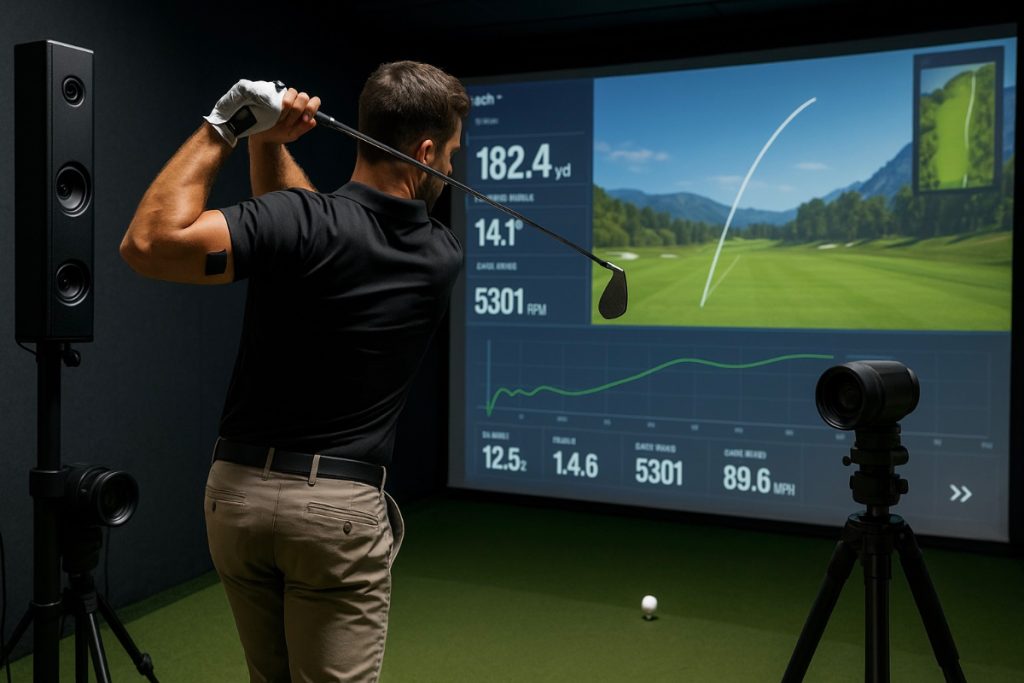 Golf is a sport where precision, technique, and consistency are key. In recent years, technology has revolutionized how players train, offering tools that enhance performance and provide valuable insights into their game. From sensors that track swing mechanics to simulators that replicate real-world courses, technology is making it easier for golfers of all levels to improve. Whether you’re a beginner or a seasoned pro, using these innovations can help you gain a competitive edge. For those who are keen on golf betting, golf betting operators in the UK on FIRST.com offer insight into how these technologies affect player performance and betting odds. Let’s explore how sensors and simulators are shaping the future of golf training.
Golf is a sport where precision, technique, and consistency are key. In recent years, technology has revolutionized how players train, offering tools that enhance performance and provide valuable insights into their game. From sensors that track swing mechanics to simulators that replicate real-world courses, technology is making it easier for golfers of all levels to improve. Whether you’re a beginner or a seasoned pro, using these innovations can help you gain a competitive edge. For those who are keen on golf betting, golf betting operators in the UK on FIRST.com offer insight into how these technologies affect player performance and betting odds. Let’s explore how sensors and simulators are shaping the future of golf training.
The Role of Swing Sensors in Golf Training
Swing sensors have become an essential tool for golfers looking to refine their technique. These sensors are attached to golf clubs or worn on the body to track key aspects of a player’s swing, such as speed, angle, tempo, and face angle. The data collected is then analyzed to provide insights that help players understand their strengths and weaknesses, allowing for more targeted improvements in their game.
Key Features of Swing Sensors:
| Feature | Description |
| Swing Speed | Measures the speed of the clubhead during the swing, which impacts distance and accuracy. |
| Clubface Angle | Indicates whether the clubface is open or closed during impact, helping to correct slice or hook issues. |
| Tempo and Timing | Tracks the rhythm and timing of the swing, which is essential for consistency. |
| Swing Path | Analyzes the path of the clubhead as it moves through the ball, helping players refine their technique. |
Using swing sensors, players can gain real-time feedback on their performance. By understanding the mechanics of their swing, golfers can make adjustments to improve their shot accuracy, power, and consistency.
Golf Simulators: Replicating Real-World Courses
Golf simulators are another technological advancement that is transforming how golfers train. These systems use high-definition screens and advanced sensors to replicate real-life golf courses, allowing players to practice in any weather and at any time. Simulators provide a variety of features that replicate the experience of playing on different courses, and they also offer detailed analytics on each shot, which is invaluable for improving game strategy and performance.
Features of Golf Simulators:
| Feature | Description |
| Course Simulation | Simulates famous golf courses from around the world, allowing players to experience different challenges and terrains. |
| Ball Tracking Technology | Uses sensors to track the ball’s trajectory, spin, and distance, providing real-time data on shot performance. |
| Shot Analysis | Breaks down each shot by measuring accuracy, distance, and club choice, helping players identify areas for improvement. |
| Game Settings | Offers the ability to adjust difficulty, weather, and course conditions to create a more realistic training environment. |
Golf simulators offer a controlled and flexible environment for players to practice, giving them access to a vast array of courses and shot data without leaving their home or training facility. These tools are especially useful for golfers in regions with harsh weather conditions, as they allow for year-round training.
Launch Monitors: Measuring Key Metrics for Better Performance
Launch monitors have become a key tool for golfers who want to take their game to the next level. These devices use radar or camera systems to capture data about the ball’s flight, such as launch angle, ball speed, and spin rate. This information is crucial for making informed decisions about club selection and swing mechanics, helping players optimize their performance.
Benefits of Launch Monitors:
| Metric | What It Measures |
| Ball Speed | Determines how fast the ball is traveling, which affects distance. |
| Launch Angle | Indicates the angle at which the ball leaves the clubface, affecting trajectory and carry distance. |
| Spin Rate | Measures the amount of spin on the ball, which influences control and stopping power. |
| Club Path and Face Angle | Analyzes the club’s path and face angle at impact, helping players fine-tune their technique. |
By providing detailed data on each shot, launch monitors help golfers identify areas of improvement, especially in terms of consistency and distance control. With this information, players can make more precise adjustments to their swing mechanics, resulting in improved shot accuracy and overall performance.
Putting Technology: Precision on the Green
While much focus in golf training is placed on the long game, putting is just as critical to a golfer’s success. Advances in technology have also impacted putting practice, with devices designed to track and improve putting stroke mechanics. These systems measure factors like stroke path, face angle at impact, and consistency, providing insights that help players improve their accuracy on the greens.
Types of Putting Technology:
| Technology | Purpose |
| Putt View | Uses high-tech visual feedback to analyze the putting stroke, helping players improve alignment and consistency. |
| Putting Mats | Simulate real putting greens with built-in slope and distance feedback to refine players’ putting skills. |
| Laser Putting Systems | Track the path and alignment of the putter, providing data on consistency and accuracy. |
| Rollers and Sensors | Measure the ball’s roll and the efficiency of a player’s stroke, helping golfers fine-tune their technique. |
With putting technology, golfers can receive detailed feedback on their technique, which is crucial for refining a consistent stroke. These tools help players focus on the finer details of their game, ensuring they can sink putts more reliably under pressure.
Wearable Technology: Monitoring Fitness and Swing Performance
Wearable technology has become a significant part of golf training, allowing players to monitor their physical condition and swing mechanics in real time. Devices like smartwatches and fitness trackers provide valuable data on heart rate, fatigue levels, and body movement, helping golfers optimize their training and avoid overexertion. This wearable tech is especially useful for tracking physical fitness, which is crucial for maintaining stamina and performance over the course of a round.
Benefits of Wearable Technology in Golf:
| Device | What It Measures |
| Smartwatches | Track heart rate, sleep patterns, and overall physical activity, helping golfers optimize their fitness levels for better performance. |
| Fitness Trackers | Measure movement efficiency, posture, and body alignment, which can influence swing performance. |
| Swing Tracking Wearables | Attach to the golfer’s body to monitor swing mechanics, providing data on tempo, path, and speed. |
By using wearable technology, golfers can gain insights into how their physical condition and swing mechanics influence their game. This allows them to make more informed decisions about their training regimen and adapt to their body’s needs for peak performance.
The Future of Golf Technology: Where is the Sport Heading?
Looking ahead, technology in golf will continue to evolve, offering new tools and innovations to help players improve. With developments in AI, machine learning, and data analytics, the potential for personalized training experiences is endless. These advancements promise to make golf more accessible and enjoyable for players of all skill levels, from beginners to professionals.
Emerging Technologies in Golf Training:
| Technology | Potential Impact |
| AI-Powered Swing Analysis | Artificial intelligence could offer even more detailed and personalized insights into a player’s swing mechanics. |
| Virtual Reality (VR) | VR systems may allow players to simulate real-world courses and practice their skills in immersive environments. |
| Biomechanical Sensors | Advanced sensors may be able to provide more accurate assessments of body movements, allowing for better injury prevention and performance enhancement. |
| Advanced Data Analytics | Data-driven tools could provide deeper insights into player behavior and optimize training plans, making them more effective. |
As technology continues to progress, golfers will have access to even more powerful tools to refine their game, whether they are working on their swing, improving their fitness, or mastering their putting technique.
Technology has had a profound impact on how golfers train, making it easier for players to refine their technique and improve their performance. From swing sensors and simulators to wearable tech and AI-powered tools, these innovations offer detailed insights into every aspect of the game. As the technology continues to evolve, golfers can expect even more sophisticated solutions to help them achieve their goals, whether they are training in a facility or practicing at home. With these advancements, the future of golf training looks bright and full of new possibilities.




















































